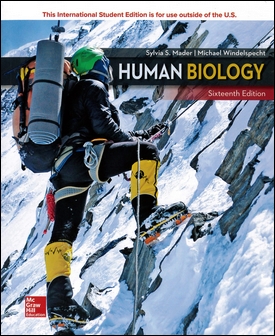書籍分類

Human Biology 16/e
作者:Sylvia Mader, Michael Windelspecht
原價:NT$ 1,250
內容介紹 目錄
- Description
Human Biology helps students understand the main themes of biology through the lens of the human body. Mader, Human Biology, aims to improve scientific literacy, while establishing a foundation of knowledge in human biology and physiology. The text integrates a tested, traditional learning system with modern digital and pedagogical approaches which stimulates and engages today’s student.
The human body an amazing biological machine, but it is one that requires internal conditions to remain within a relatively narrow range of conditions, called homeostasis. Despite the environment we are in, the systems of our body must work together to maintain these conditions. In the case of the mountain climber on the front cover, the increase in altitude not only brings about colder temperatures, but also a decrease in oxygen and moisture levels.
As you climb a mountain, your respiratory system must increase the rate of breathing so that enough oxygen is received to power the brain and muscles of the body. Since climbing is strenuous work, the endocrine system must ensure that the level of glucose in the blood is adequate to meet the demand of the muscles and heart. At the same time, the endocrine system instructs the urinary system to decrease urine production, thus conserving water.
By processing thousands of signals from the internal and external environment, the nervous system acts as the central command for the body's response. If our body temperature begins to drop outside of an acceptable range, the nervous system can redirect blood flow from the extremities or introduce shivering in the muscles. If the climber experiences severe exertion, the nervous system will detect an elevation of carbon dioxide in the blood and instruct the respiratory and circulatory systems to increase activity.
Throughout the text, you will learn more about the complex interactions that occur within the human body. From a genetic, to a cellular, and on to a physiological level, the same processes that make hiking to the top of a mountain possible also control our bodies during our daily activities.By understanding how our bodies function, we can gain a greater understanding of how to prevent disease and lead a healthier life.
分類位置:
理工 > 生命科學 > 生物學


